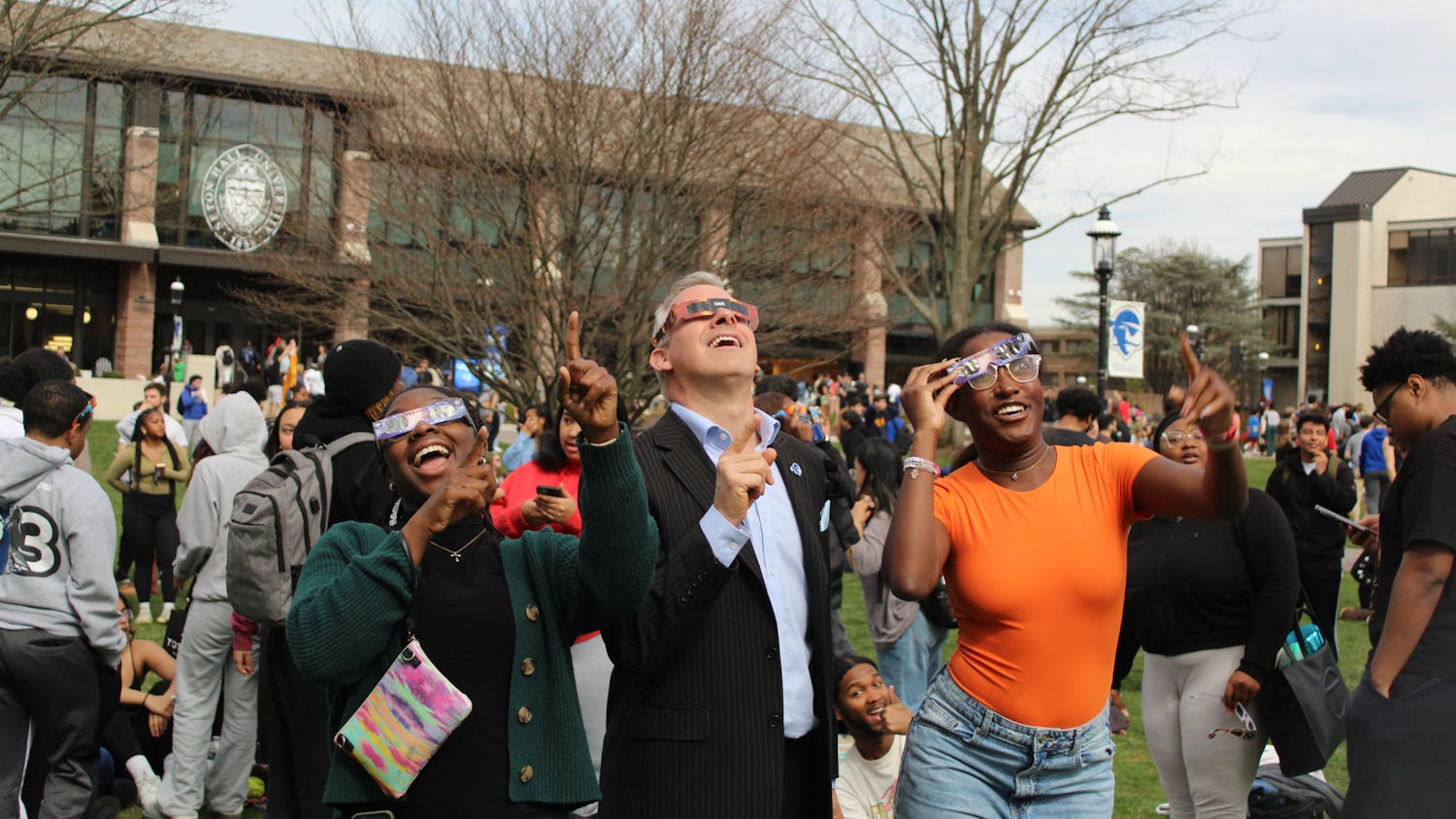[caption id="" align="alignnone" width="400"] collegeprofiles.com[/caption]
The Seton Hall Transfer Center is holding a workshop this month on basic guidelines to follow during the registration process for the spring 2016 semester to ensure that students know their specific curriculum.
The center will also be hosting “What’s Next?” session on Nov. 18 and Nov. 19 on what to expect for future semesters involving internships and other opportunities that arise once transfer students are accustomed to the University.
Alyssa McCloud, vice president of Enrollment Management, says that about 900 to 950 transfer students are admitted to Seton Hall every year.
“Of course, not every student you admit comes. It’s common that a lot of people think they want to come and then they decide not to when they are deciding between multiple schools, so this fall we had 260 (enrolled transfer) students,” McCloud said.
Even though the transfer student body is less than one-fourth of its whole freshman incoming class, which estimates about 1250 students per year, most transfer students are faced with the same problems as freshmen.
Students experience many emotions when coming to a different school; from the difficult stresses of experiencing a new and more intense academic workload to the simpler stress of knowing when, where, and how to get involved.
These are just some of the challenges transfer students face that can make them feel out of the loop at times.
“I have to say that my first semester here was definitely one of the hardest I’ve ever had,” said Jean-Paul Duran, a transfer student from Bergen Community College. “My first semester I took calculus and the workload was unbelievable and finding a tutor wasn’t easy for me because I didn’t know where anything was.”
Duran obtained an Associate of Science degree in exercise science from Bergen Community. He is currently a biology major in the 7 year dual-degree Doctor of Physical Therapy program.
“You see that a lot of students here all know each other and have study groups. I guess as transfer students we just feel secluded,” Duran said.
Some transfer students are unaware of the programs that Seton Hall has to help them transition.
“We wanted to create a home for the transfer students,” said Hezal Patel, director of the Center and mentor of Freshman Studies, said. “This is the home base where transfer students can start and come at any time if they need any assistance.”
The Center provides academic advising and mentors to guide transfer students through their first and subsequent years at Seton Hall.
The Center creates voluntary workshops as resources to provide information to students and works with departments like the Ruth Sharkey Academic Resource Center (ARC) on campus to increase awareness of its available resources.
“Helping to increase social bravery is definitely a goal which is why we try to have these events where people can gather and interact… because at the end of the day we want you to feel like a Seton Hall student… so a lot of the activities that we run, we want the general student population to come in too,” said Brandon Larmore, who advises freshmen, general studies and transfer students.
Seton Hall also offers help academically. A transfer student is considered any student who has attempted at least 6 college credits after high school graduation.
For transfer students coming into the University with less than 30 credits, Seton Hall requires a one-hour long, once-a-week University Life course in order to graduate. In contrast, those coming in with over 30 credits or an associates degree can receive waivers.
“Lately I’ve been thinking that maybe this is something that should be offered to all transfer students regardless of the credit level,” said Patel, who is teaching a class this semester. The class teaches students how to be successful at Seton Hall using author Stephen Covey’s “7 Habits of Highly Effective People.”
Sara Frank, a first semester transfer student majoring in business administration with a specialization in marketing, said that in addition to the academic help, there should be more social events on campus catered to transfer students.
“Socially it is just different now, having to live on campus when before I was so used to going home and getting my work done with no distractions,” Frank said. “Coming here it’s more about forming actual relationships with people because you’re living with them and you’re dealing with more than what you would be dealing with than what you would be at home.”
The Student Activities Board (SAB) does its best to accommodate events with student schedules and strives to reach out to more commuter and transfer students with “pop-up shop” events.
“The pop-up shops are an opportunity for students to enjoy themselves for a short period of time in between their classes and other responsibilities,” Mariel Pagan, assistant dean of Student Activities said. “In addition to the pop-up shops SAB has made an effort to host some evening events earlier in the evening at 6 p.m. instead of 8:30 p.m., so that commuter students don’t have a large gap between their classes and the event.”
Stephanie Garcia can be reached at stephanie.garcia1@student.shu. edu
collegeprofiles.com[/caption]
The Seton Hall Transfer Center is holding a workshop this month on basic guidelines to follow during the registration process for the spring 2016 semester to ensure that students know their specific curriculum.
The center will also be hosting “What’s Next?” session on Nov. 18 and Nov. 19 on what to expect for future semesters involving internships and other opportunities that arise once transfer students are accustomed to the University.
Alyssa McCloud, vice president of Enrollment Management, says that about 900 to 950 transfer students are admitted to Seton Hall every year.
“Of course, not every student you admit comes. It’s common that a lot of people think they want to come and then they decide not to when they are deciding between multiple schools, so this fall we had 260 (enrolled transfer) students,” McCloud said.
Even though the transfer student body is less than one-fourth of its whole freshman incoming class, which estimates about 1250 students per year, most transfer students are faced with the same problems as freshmen.
Students experience many emotions when coming to a different school; from the difficult stresses of experiencing a new and more intense academic workload to the simpler stress of knowing when, where, and how to get involved.
These are just some of the challenges transfer students face that can make them feel out of the loop at times.
“I have to say that my first semester here was definitely one of the hardest I’ve ever had,” said Jean-Paul Duran, a transfer student from Bergen Community College. “My first semester I took calculus and the workload was unbelievable and finding a tutor wasn’t easy for me because I didn’t know where anything was.”
Duran obtained an Associate of Science degree in exercise science from Bergen Community. He is currently a biology major in the 7 year dual-degree Doctor of Physical Therapy program.
“You see that a lot of students here all know each other and have study groups. I guess as transfer students we just feel secluded,” Duran said.
Some transfer students are unaware of the programs that Seton Hall has to help them transition.
“We wanted to create a home for the transfer students,” said Hezal Patel, director of the Center and mentor of Freshman Studies, said. “This is the home base where transfer students can start and come at any time if they need any assistance.”
The Center provides academic advising and mentors to guide transfer students through their first and subsequent years at Seton Hall.
The Center creates voluntary workshops as resources to provide information to students and works with departments like the Ruth Sharkey Academic Resource Center (ARC) on campus to increase awareness of its available resources.
“Helping to increase social bravery is definitely a goal which is why we try to have these events where people can gather and interact… because at the end of the day we want you to feel like a Seton Hall student… so a lot of the activities that we run, we want the general student population to come in too,” said Brandon Larmore, who advises freshmen, general studies and transfer students.
Seton Hall also offers help academically. A transfer student is considered any student who has attempted at least 6 college credits after high school graduation.
For transfer students coming into the University with less than 30 credits, Seton Hall requires a one-hour long, once-a-week University Life course in order to graduate. In contrast, those coming in with over 30 credits or an associates degree can receive waivers.
“Lately I’ve been thinking that maybe this is something that should be offered to all transfer students regardless of the credit level,” said Patel, who is teaching a class this semester. The class teaches students how to be successful at Seton Hall using author Stephen Covey’s “7 Habits of Highly Effective People.”
Sara Frank, a first semester transfer student majoring in business administration with a specialization in marketing, said that in addition to the academic help, there should be more social events on campus catered to transfer students.
“Socially it is just different now, having to live on campus when before I was so used to going home and getting my work done with no distractions,” Frank said. “Coming here it’s more about forming actual relationships with people because you’re living with them and you’re dealing with more than what you would be dealing with than what you would be at home.”
The Student Activities Board (SAB) does its best to accommodate events with student schedules and strives to reach out to more commuter and transfer students with “pop-up shop” events.
“The pop-up shops are an opportunity for students to enjoy themselves for a short period of time in between their classes and other responsibilities,” Mariel Pagan, assistant dean of Student Activities said. “In addition to the pop-up shops SAB has made an effort to host some evening events earlier in the evening at 6 p.m. instead of 8:30 p.m., so that commuter students don’t have a large gap between their classes and the event.”
Stephanie Garcia can be reached at stephanie.garcia1@student.shu. edu

Comments




